10 charts showing Wales since the devolution vote
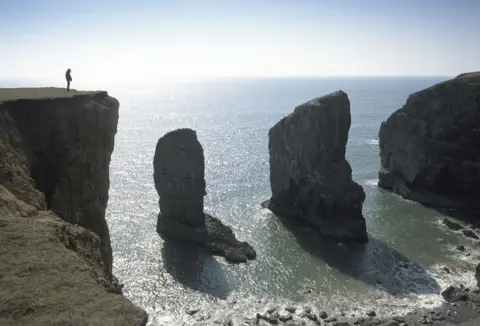 starekase/Getty Images
starekase/Getty ImagesHow has Wales changed since 1997? That's a big subject. But here are 10 charts giving you a snapshot of how things might be a bit different - or in some cases, pretty much the same.

1 How is the economy performing?
This measure looks at how much money is generated per person per year through goods produced and services delivered.
The most recent regional gross value added (GVA) figures from the Office for National Statistics (ONS) show Wales had the lowest GVA per head of UK nations and regions at £18,002.
Poorer areas like west Wales and Valleys - which stretch from Anglesey, down to Pembrokeshire and across to the old Gwent valleys - are even further behind.
When you look at incomes, back in 1997, the gross disposable household income in Wales was 86.3% of the UK figure. The most recent figure, for 2015, shows the gap has widened slightly and it is 85.5% of the UK figure.
Some experts say we also need to look at levels of debt and personal borrowing, which suggest that people are struggling.

2: Poverty affects nearly a quarter of households
Tackling poverty in Wales has been a constant theme over the last 20 years from both ministers and charities. There has been a target to eradicate child poverty by 2020 but ministers have said they do not have the powers to make enough in-roads.
Latest figures show around 400,000 working-age adults in Wales are in households with less than 60% of median household income in the UK - the yardstick for measuring poverty.
This chart shows that the proportion of people living in this category - after housing costs are taken into account - has dropped but remains at 23%.

3: Progress in tackling 'the biggest killer'
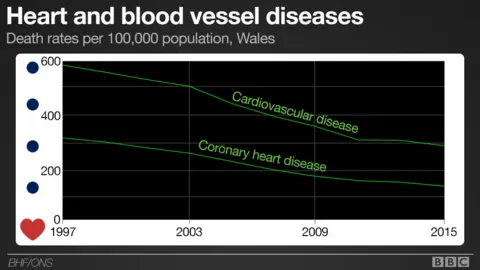
Heart and circulatory diseases - grouped together as cardiovascular disease (CVD) - are responsible for more than 9,000 deaths in Wales a year.
Within that, coronary heart disease is Wales' biggest killer - responsible for 11 deaths a day. It is responsible for nearly three times as many deaths among women as breast cancer.
A fall in the death rate from CVD since the 1960s - accompanied by the healthier lifestyle message hitting home - has included a steady decline over the last 20 years.
But there are still worries about inequalities and people dying too early. In Wales, for those under 75 there are 78.4 deaths per 100,000 from CVD - worse than any region of England, apart from the north west. A study for the British Heart Foundation found in parts of the south Wales valleys the death rate is higher than 100.
The life expectancy in Wales, although still trailing that in England, has risen between three and four years. It was just under 74 for men and 79 for women in 1997; the most recent figures are just over 78.5 for men and just over 82 for women.

4: We smoke and drink a bit less
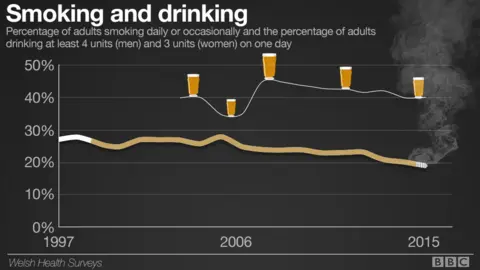
The smoking ban in public places came into force in Wales in April 2007 a few months ahead of England - with hopes it would encourage more smokers to stub it out.
The ban has changed the environment of pubs, restaurants, sports stadiums, public transport and workplaces.
When it was introduced, it was claimed that 25,000 smokers in Wales wanted to quit and we can see the proportion who smoke has now fallen to less than a fifth. There are now an estimated 65,000 fewer regular smokers since the restrictions came into force.
As for alcohol, it is suggested there is still an issue with binge drinking in Wales - but there has been a fall in recent years in the number of people who drink more than three or four units in one day.

5: More micro businesses
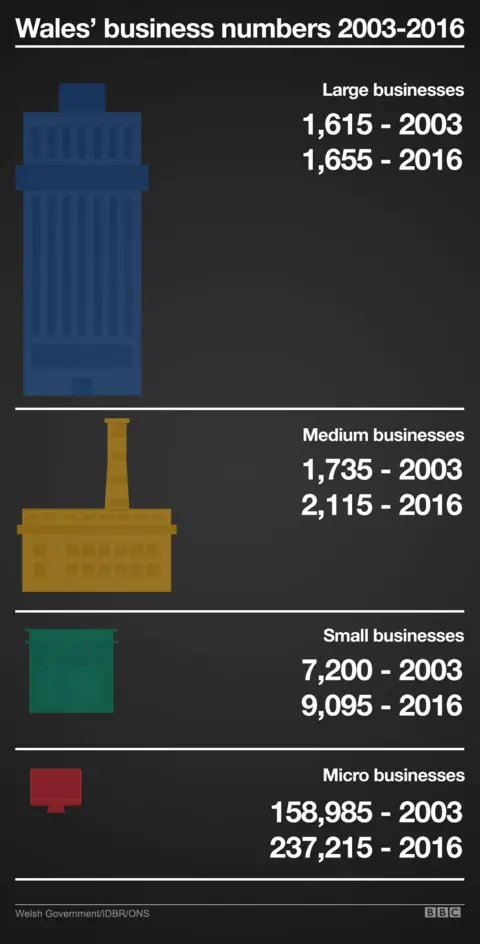
Self-employed people and micro-enterprises - which employ between one and nine people - already made up a high proportion of Welsh businesses.
But the numbers have swelled, rising from just under 159,000 in 2003 to 237,215 micro businesses in 2016. This is now 95% of all businesses in Wales. Merthyr has the lowest and Powys the highest proportion.
The image of Wales as one of heavy industry is long gone although numbers working for large companies - those with a workforce of more than 250 - have risen by 12%. And there was also a bigger growth in employment with foreign-owned firms than UK-owned companies.
Despite cutbacks, the proportion of people working in the public sector has actually risen to 27.3%, slightly more than in 2001.

6: Serious road casualties fall
There are more motorists on the roads of Wales than there were 20 years ago - but fewer serious crashes.
Just over 1,000 people were badly injured on Wales' roads last year, with more than 100 killed.
This is however half way towards a target of cutting serious casualties by 40% from the average between 2004 and 2008.
This is also despite the numbers of cars on the roads in Wales rising by 427,000 since 1997. Traffic volume has also risen from 24.18 billion km to 28.40 billion km.
There is a target of cutting serious motorcycle casualties by 25% by 2020, although little progress has been made on this.

7: GCSE results have improved
If you enjoy statistics, then education in Wales has plenty. You could even take an exam in them. It offers a mixed bag. Most notably perhaps there have now been four lots of Pisa results - which compare 15-year-olds internationally in reading, maths and science, none too favourably.
On the other hand, teenagers' performance in GCSE results has been one of continual improvement since 1997.
The gender gap has been a feature of the last 20 years. Although it has narrowed a little in recent years, those in education admit it is a stubborn feature with boys taking 10 years to reach where the girls were in 1997.

8: Falling short on climate emissions
Wales is responsible for 9% of carbon emissions in the UK but although emissions are lower than 20 years ago, it is expected that Wales will miss its target to reduce greenhouse gas emissions by 40% by 2020.
It has currently achieved a 20% reduction, according to latest figures. The target is set to get tougher with an 80% reduction from 1990 levels by 2050.
Wales is doing better in other areas of environmental policy, for example it met its recycling target four years early.

9: We're online, we're mobile
Devolution is as old as, well, the internet. The BBC news website itself was only properly launched in December 1997, after a few trial pages like the one below to cover the new Labour government under Tony Blair. Future digital archaeologists will have a virtual museum to this period.

Technology has changed rapidly. Internet connection was little more than a man and his mouse 20 years ago. Does anyone else miss the sound of a modem dialling up? This is for you kids. Just looking at how quickly people hooked up to the web is only a snapshot of how transformative it has been to how we work, rest and play.
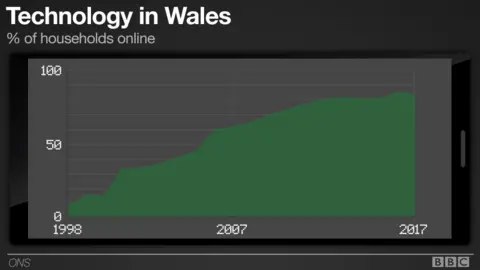
It has not been without its challenges in rural areas but most of Wales is now pretty much online. The latest figures show 84% of households are connected to the internet.
As for mobile phones, they've got smaller - some would say smarter - and practically every home in Wales has someone with one. Back in 1998, only 16% of us had one. Now it's 94% who have a mobile.
Keeping them turned on is another thing. According to the ONS's latest survey, 10% of us say we haven't switched our phone on in the last three months.
4G coverage is also improving, according to Ofcom, but Wales still lags behind the whole of the UK when you are outside, with less than half the country having a service. And Wales also comes off worst in the UK with the slower 3G networks.

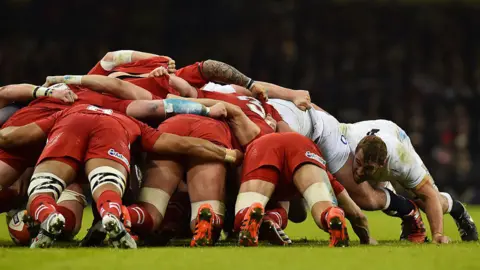 BEN STANSALL/Getty Images
BEN STANSALL/Getty Images10: The Welsh rugby team has bulked up
Professionalism in rugby was in its infancy back in 1997. But how big has the physical change in the game been in the last 20 years? How much bigger are Welsh rugby players? The combined weight of the team that lined up against England 20 years ago was 1,383kg - that's an average of 92.2kg (14.5st).

But if we take that fixture in particular to weigh up the differences, there has been a definite increase - peaking in 2015 with a total weight of 1,625 kg in the starting line-up. That combined heft is a bit more than a family-sized car or an average 108.3kg (17st).
This has not been a phenomenon unique to Wales but there is a suggestion it has reached a plateau as the game is getting faster. Last year's Six Nations starting line-up was the lightest in a decade.
Rugby might have the biggest players - but which is the biggest sport in Wales? Football might stake a claim, especially after Wales' semi-final placing in Euro 2016. But it will take more than a single chart to settle that argument.
